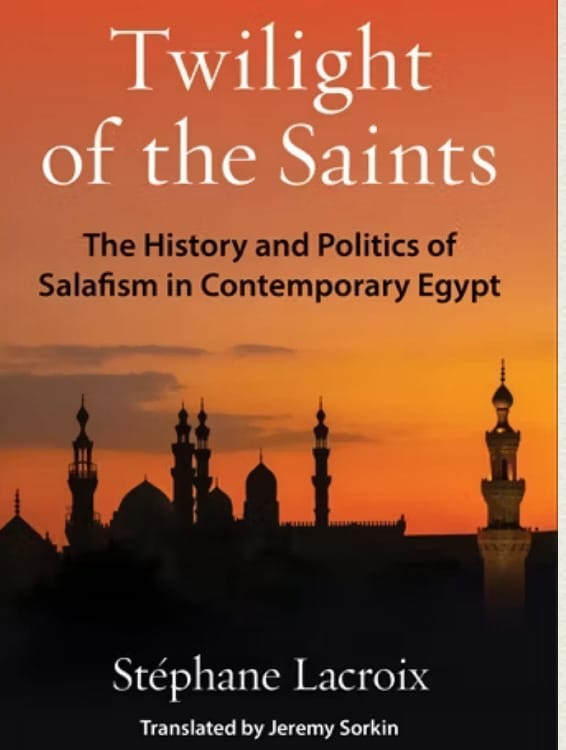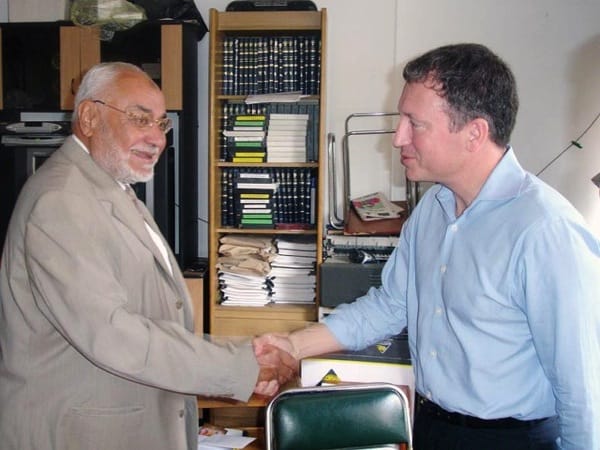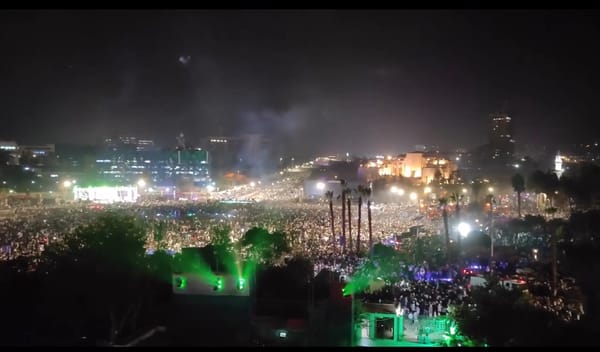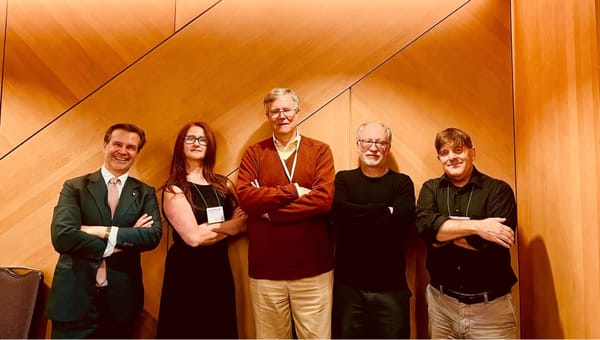Twilight of the Saints

Stephane Lacroix's spectacular new book on Islamism in Egypt, plus (perhaps) the last MENA Academy scholarship roundup of the summer
The end of the summer is fast arriving, I'm afraid. Last week, I offered up some grim forecasts for the coming semester along with a long list of suggestions for Middle East politics syllabi. For me, I will be back teaching at GW's Elliott School after a year off on parental and research leave. I'm excited to be back in the classroom; at first it was a bit overwhelming thinking through how much had changed since fall 2023 – the last time I updated my International Relations of the Middle East syllabus. It's a very interesting and useful exercise to think through which changes are really fundamental, which are important but not transformative, and which will likely prove fleeting (questions which a great group of scholars took up in this recent volume of POMEPS Studies). It's interesting enough that I'm contemplating writing a....but no, that can wait.
For now, I'd like to do one last MENA Academy roundup for the summer, featuring a long-anticipated new book in my series Columbia Studies in Middle East Politics and the latest new academic publications on the region.
The MENA Politics book of the week: Twilight of the Saints: The History and Politics of Salafism in Contemporary Egypt by Stéphane Lacroix (Columbia UP 2025), newly translated from the French and published in the US just a few days ago. Lacroix is well known to most students of regional politics for his work on Islamist movements and the Gulf. His 2011 book Awakening Islam, on Saudi religious movements, ranks high on my personal list of the best books on Middle East politics of the last couple of decades. Awakening Islam stood out at the time not only for its deeply researched and innovative analysis of the role of Islamist dissidents in the Saudi political system but also for its identification of key transnational connections shaping Islamic politics in both directions – not just Saudi promotion of Wahhabist salafi forms of Islam abroad but also the impact of (especially but not exclusively) Egyptian forms of Muslim Brotherhood-style Islamism on the Saudi religious field.
After Awakening Islam, Lacroix shifted his attention to Egypt, spending much of the last fifteen years deeply researching the history and evolution of its salafi movement. Twilight of the Saints is a towering accomplishment, a definitive and groundbreaking account of Egyptian salafism which weaves together politics, theology, institutions, and intra-Islamist contention into an authoritative account of a still relatively understudied trend. (There are exceptions, of course: see my review of Aaron Rock-Singer's exellent book on Egyptian salafism a couple of years ago for more). Lacroix places Egypt's salafi movement fully within the broader context of the country's complex and constantly changing Islamic field, showing how it was shaped by interactions and competition with the Muslim Brotherhood, violent jihadist movements, al-Azhar and the religious establishment, and new forms of televised and online Islamic evangelism. He places particular attention on the competition between salafis and the Muslim Brotherhood, carefully tracing the ways in which the state put its thumb on the scales in favor of the former. At the same time, he takes salafism seriously as a movement, tracking its institutional dynamics and internal schisms and debates.
Twilight of the Saints is a book which should be read by anyone who works on Middle East politics, not just Islamist movements (though of course they should all read it too). It does what political science should do, showing how a religious movement and an authoritarian environment interact to produce often surprising results. It will answer many questions about how and why the salafis turned to electoral politics after 2011 after long shunning such activities, and how and why they navigated the 2013 coup and counter-revolutionary repression. I'm proud and delighted to have it published in my Columbia series.
MENA Academy Roundup
There's a lot of great scholarship that's come out in the last few weeks. We begin with Syria, with another innovative article by Samer Abboud, the release of a new issue of the Syrian Studies Association Bulletin, and a piece by Robin Jones on the south of Syria during the war. The latter piece was published in Interventions, the premiere journal of postcolonial studies, as part of a full set of highly original and challenging Middle East focused articles based on a conference on Gramsci in its current issue; I link to some of the other highlights, including articles by Bassel Salloukh on Lebanon, Joshua Rigg on Tunisia, Hisham Bustani on Jordan, and Shahenda Suliman on Sudan. I then link to two fascinating pieces on the Gulf – Hannes Baumann and Alice Hooper's examination of the emergence of a Gulf-centric pan-Arab business elite, and Kristian Coates Ulrichsen's analysis of the new transactionalism in US-Gulf relations. Finally, we present an article by Ina Filkobski and Eran Shor on the role of the Knesset in the escalating repression of Israeli NGOS, and a fascinating piece by Chihab al-Khashab on what it's really like doing research in the Egyptian state archives.
Samer Abboud, "Business elites, private security companies, and conflict management in Syria," Conflict, Security and Development (July 2025). ABSTRACT: A conflict elite emerged in Syria amidst metastasizing violence and economic contraction. This conflict elite began as economic intermediaries before taking on major roles in Syria’s war economy as well as positions of nominal political power on the boards of major chambers’ and holding companies. In these roles, many funded and controlled private militias to support the regime’s battlefield strategy. A Russian-led de-militiafication programme transitioned these militias into private security companies (PSCs) after 2015. In this paper, I ask several questions about how the conflict elite that emerged was funnelled towards the operations of PSCs as part of a larger regime strategy of conflict management and survival and what their roles tell us about state-business relations. I argue that PSCs provided opportunities for rent distribution that allowed the regime to foster and marshall a loyalist elite towards conflict management goals. The PSCs embed conflict elites, current and former security officials, and military leaders into entanglements that blur the lines between public and private, conflict and security. In intermediating between conflict and security, PSCs serve an important role in the regime’s conflict management strategies.
The Syrian Studies Association Bulletin has a new special issue focused on the fall of Asad and the hopes for a new Syria. Standout contributions include Mohammed Fatih's analysis of official Islamic discourse in Idlib under rebel control from 2019-24: "the Ministry of Awqaf in opposition-held Idlib, created after rebel consolidation in 2019, fostered a disciplined yet socially pervasive religious sphere that sustained the five-year campaign culminating in the fall of Damascus on 8 December 2024. Drawing exclusively on two investigative field reports, it traces the Ministry’s top-down initiatives—from sermon centralization and Qurʾān institutes to family-counseling centers and prison rehabilitation—and places them beside the bottom-up ethos of volunteer piety and prophetic-sīra0F1 study that animated fighters on the front lines. The analysis shows that the synergy between bureaucratized religion and lived devotion bound civilians and combatants into a single moral community, muted intra-Sunni doctrinal disputes, and offered a template for revolutionary governance." Michael Provence also has a fascinating vignette of his recent visit to the Syrian National Archives, alongside a number of interesting short pieces about a Syrian in transition.
Robin Jones, "Syria’s “Southern Question”? Class, geography and organization in the 2011 Syrian revolution and war," Interventions (July 2025). ABSTRACT: This essay analyzes the geo-social dynamics of the 2011 Syrian revolution and the ensuing war, in conversation with Gramsci’s 1926 essay “The Southern Question.” Gramsci’s theorization of uneven geographical development between Italy’s North and South is situated as relevant to the divide between urban cores and peripheral/provincial regions in contemporary Syria. Reversing the pro-rural, pro-poor policies of 1960s Ba’athist regimes, the neoliberal reforms of the 2000s devastated Syria’s countryside and spurred widespread rural migration to informal neighborhoods on the outskirts of cities. Subsequently, the 2011 revolution found a social base in the impoverished peripheries and downtrodden provincial regions, while wealthier urban populations remained largely quiescent. With militarization and repression, hardline Islamist groups were able to gain support among segments of the rural and peripheral popular classes, as the essay illustrates through a case study of the town of Manbij. Due to their relative lack of organizational ties prior to the revolution, these classes exhibited a potential for volatility between political projects of various orientations, in this regard resembling the Southern peasantry in Gramsci’s analysis. Yet whereas Gramsci draws a stark distinction between two alliances that Southern peasants might pursue – a reactionary bloc with the Southern bourgeoisie, or an emancipatory alliance with Northern urban workers – the Syrian war saw the emergence of a more complicated set of political tendencies. Hardline Islamists did assemble a regional bloc between a fraction of the provincial bourgeoisie and informal workers, but did so by channeling mass discontent with elite-led mainstream opposition institutions toward a regressive alternative. The essay briefly seeks to rectify Gramsci’s potentially paternalistic contention that rural subaltern classes must be led by an external force, turning to Fanon’s writings on rural revolutionary subjectivity, as well as Gramsci’s own conception of the articulating role of the revolutionary party in a subaltern alliance.
Bassel Salloukh, "The Anatomy of Lebanon’s Postwar Integral State: The Political Economy of Cartels and Consent," Interventions (July 2025). ABSTRACT: This essay stretches Antonio Gramsci’s core concept of the integral state to explain an enigma in contemporary Lebanon: why the massive collapse after the October 2019 protests failed to generate commensurate political, ideological, and organizational responses. It retheorizes the post-civil war state in Lebanon as a different kind of integral state, one that reflects an alternative process of state formation and historical trajectory in the Global South producing different state forms, class fractions, and social formations than those in Europe. In this case, private elite interests expressing different class fractions operate not by defining the ethical content of the state in civil society, nor by organizing consent on the cultural front of civil society, but overlap directly with state structures. Stretching Gramsci’s conceptual toolkit dissolves the differences between the state and society, and captures analytically how the postwar political economic elite representing an alliance of class fractions placed the state’s fiscal and monetary policies at the service of capital accumulation, but also to integrate substantial social constituencies into the postwar order along strictly sectarian clientelist incentives. This disaggregated cross-sectarian class interests and provided the material conditions to secure a level of sectarian ideological consent that precluded the emergence of viable political alternatives in the postwar era. The operations of the postwar integral state also truncated the terrain of civil society on which alternative organizational formations could organize in the long war of position to subvert the ideological hold of the sectarian system. The anatomy of this postwar integral state is examined as expressed in the political economy of cartels.
Joshua Rigg, "Independence fighters and flour sacks: common sense, colonial subjectivities and revolutionary afterlives in Tunisia," Interventions (July 2025). ABSTRACT: The concept of “afterlives” has been used to follow the asynchronous temporalities of the Arab uprisings and the traces of colonial, anti-colonial and neo-colonial histories in the present. This essay considers two colonial subjectivities that have haunted Tunisia’s post-overthrow moment. It argues that the contrasting figures of the fellaga, or armed anti-colonial independence fighters, and tahhana, native informants, are forms of popular knowledge that have been used to make moral and political claims regarding Tunisia’s uneven and unfinished revolutionary process. To help outline these two subjectivities and their political articulation, the essay draws on Antonio Gramsci’s dialectic of common and good sense, stretching his thinking to the Tunisian context. The essay argues Gramsci allows us to stay with the socio-historical effects of popular thinking, and the strategies that turn inchoate, fragmentary knowledge into “good” sense.
Hisham Bustani, "Preparing for revolutionary times? Chronic crisis of authority and constructive subversion in contemporary Jordan," Interventions (July 2025). ABSTRACT: Utilizing a multidisciplinary approach rooted in the methodology of participatory action research, this essay uses the lens of praxis to explore how Gramscian concepts, in conversation with ideas proffered by Alain Badiou, Jodi Dean, and the intellectuals of the Paris Commune, can help us understand, and possibly overcome, the socio-political stalemate characteristic of current polities in the Arab region. As a path to breaking the logjam, this study advances the concept of “constructive subversion”, arguing that politics must be engaged from autonomous liberated political spaces. Such spaces are required for the processes of mass intellectualization, advance preparation, theoretical and practical experimentation, political creativity and dynamism, and the deepening of the chronic crisis of authority necessary to the revolutionary moment to increase the likelihood of its transformation into a revolutionary movement that is able to effect change. The essay also presents a case study of the National Jordanian Campaign for the Abrogation of the Gas Deal with Israel as a model of such a liberated space, elaborating on the campaign’s mechanisms of action and organization, the challenges it faces, and some of the techniques it utilizes to minimize the effects of authoritarian intervention and fragmentation.
Shahenda Suliman, "Subaltern Formations and Sudan’s 2018–2019 Uprising," Interventions (July 2025). ABSTRACT: This essay explores the role of subaltern groups in Sudan’s 2018–2019 uprising and the immediate aftermath of Bashir’s overthrow, with a specific focus on relations between various subaltern groups and the middle classes. It begins by briefly mapping out some of the social, political, and economic transformations during the National Islamic Front’s (NIF) reign that gave rise to new subaltern formations, before focusing on the uprising itself. Drawing primarily on recent translations of Gramsci’s writings on subaltern groups and research in Sudan during and after the uprising, it then aims to shed light on shifting solidarities, tensions, and divisions between subaltern groups and the middle class in particular, with a focus on the role of nationalism(s) in unifying and fragmenting social groups at different periods. It illustrates how these groups mobilized and articulated their opposition to the regime through multiple and at times divergent appeals to nationalism, memories of past resistance, and labour revolt harking back to the colonial period, before exploring some of the tensions and contradictions brought to the fore in the post-Bashir period and emergence of organizations representing subaltern groups. In doing so, it interrogates the possibility and challenges of building subaltern hegemony in contexts such as Sudan in the present conjuncture, with particular attention to the regional and international.
Hannes Baumann and Alice Hooper, "The Development and Political Effects Of a Pan-Arab Corporate Elite," Middle East Policy (July 2025). ABSTRACT: Gulf investment across the Arab states has skyrocketed since the 2000s. Such activity not only links corporate entities but also weaves new connections between business leaders. We take a birds-eye view of the pan-Arab corporate elite by analyzing the network of transnational interlocking directorships. These involve directors who sit on boards of two or more firms headquartered in different countries. We include 1,111 directors of the 135 largest firms from across the Arab world. A transnational pan-Arab corporate elite has indeed emerged, though it is less dense than its counterparts in regions such as Europe or Latin America. The network radiates from the Gulf to other parts of the region. Arab autocrats may find it more difficult to maintain political control of transnational corporate elites than domestic business leaders, who tend to be more reliant on regime goodwill. But transnational corporate elites are more likely to push for further neoliberal restructuring and regional economic integration than for democratization.
Kristian Coates Ulrichsen, “Transactional Politics: Rethinking US-Gulf Security and Defense Relationships Among US Decline,” Alternatives (2025). This article analyses the shifts in security and defence policies across the six states of the Gulf Cooperation Council (GCC) and disentangles political and geopolitical strains in the U.S.-Gulf relationship from practical measures to boost cooperation and deepen interoperability. In examining the trajectory of security and defence relationships, the article assesses the stability and durability of the underlying components of U.S.-Gulf partnerships in a time of rapid change. The article begins a section that details how and why the perception of U.S. disengagement has evolved, despite ongoing reliance on facilities such as Al-Udeid in Qatar for forward basing arrangements, before a second section examines regional responses to the withdrawal from Afghanistan in 2021, the Russia-Ukraine war in 2022, and the Israeli war in Gaza that erupted in 2023. A third section explores the ‘nuts and bolts’ of security and defence relationships and considers issues such as U.S. arms sales and Department of Defense programs, such as Red Sands in Saudi Arabia and the Comprehensive Security Integration and Prosperity Agreement with Bahrain, as ways to boost cooperation in the face of political tension and stiff competition. As U.S. troop levels have ebbed and flowed, a final section considers whether a more flexible approach to security relationships is sustainable in a far more transactional era of international power and politics.
Ina Filkobski and Eran Shor, "Legislative processes, nonstate actors, and political repression: the case of human rights NGOs in Israel," Social Forces (July 2025). ABSTRACT: Previous research on legislation that targets nongovernmental organizations working on human rights issues (HR NGOs) has mostly focused on state actors in authoritarian regimes. In this study, we theorize the role of nonstate actors in political repression in a relatively more democratic setting, that of Israel. We conducted a systematic content analysis of thousands of legal documents, parliamentary archives, and media reports, complementing these with ethnographic work in several NGOs and in-depth interviews with NGO staffers. In contrast with theoretical views that see legislative processes as merely window dressing, we found that the Israeli legislative process has had a profound impact on Israeli HR NGOs, entailing a significant loss of public and political support, legitimacy, and scarce resources. We argue that scholars of political repression must pay greater attention to the crucial role played by nonstate actors in advancing and enforcing repressive legislation and to the entire legislative process—rather than only its formal legal results.
Chihab al-Khashab, "Notes on the Difficulty of Studying State Archives in Egypt," Comparative Studies in Society and History (July 2025). ABSTRACT: This article describes how Egyptian state documents are scattered between governmental institutions, private collections, and the second-hand book and paper market. This scattering raises a practical question about the conditions under which official documents become discardable and commodifiable by bureaucrats, their families, and second-hand dealers. This scattering also raises a theoretical question about the nature of a state which takes uneven care in keeping a record of its own institutional past. After outlining the difficulties of access one faces in official archives in Egypt, the article fleshes out the sociological profile of different custodians of state paperwork—including families of bureaucrats, peddlers, and dealers—and the conditions under which state documents become commodified to this day. The overarching objective is not just to show the well-known limitations of national archives as a source of historical material, but also to show how actually existing “state archives” go well beyond the remit of official institutions, with notable consequences over our conception of the state.



